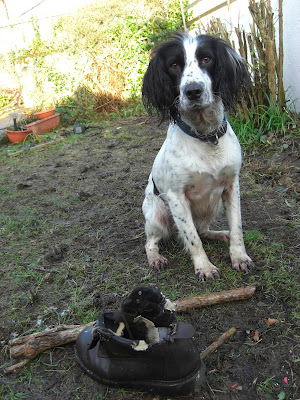The Dream Team
I’m contemplating hiring my dogs out. I think they would make the perfect rotovating duo when it comes to totally eradicating grass from the garden, turning the resulting ground into mud then filling the space up with chewed up work boots and garden ornaments. I’m not sure there would be much of a market for this though but at least the lawn would have a bit of time to mend itself as they played somewhere else for a while. Don’t get me wrong, I love having them “helping out” in the garden, it just means that when it comes to garden design, most of the features you read about to include in the plan go out of the window and are replaces with chicken wire, concrete slabs, six foot fences and shrubs that would spring back up again after a JCB had run over them.
Crazy
Of course not all dogs go crazy in the garden, some of them are very well behaved, use paths, leave plants alone and don’t spend all day looking longingly at the fish in the pond as their appetizer for dinner. Our dog Chips spends a considerable proportion of her free time in the evenings staring at our one remaining guinea pig in his cage. I think they are really good friends as Chips always wants to be looking through the bars. This was confirmed a day or two ago when the cage somehow fell over and the guinea pig escaped into the garage. They still just stared at one another and I am sure if either of them had tails, they would be wagging.How to plan the Doggy Garden
If the garden needs a makeover to accommodate a dog then the layout might need to be changed a bit. Frequently used grass paths are likely to become worn and muddy in wet weather if the dog uses it as a path. Bricks or paving stones along the routes the dog uses most frequently can be effective rather than grass cover. By doing so, you can greatly reduce the maintenance levels of you garden. Hard materials such as brick, slab or stone can also be easily hosed down if your dog messes on them.Moving around the garden is an important factor; try to make it easy and enjoyable for the dog. Beware of slippery surfaces, especially in wet weather. Cover slippery steps with mesh or some other material to increase traction.
Take your dogs' age and physical condition into account and make adjustment accordingly. Ensure they have easy access to the house, their kennel, water bowls, shaded areas and their favourite spots in the garden.
Protecting Flower Beds
Flower beds in central areas of your garden are vulnerable to damage caused by the dog running through them or playing in them. Damage often occurs in flower beds separating two open areas of lawn or paving. Dogs often charge straight through these to get from one area of the garden to another, and plants may be trampled and crushed. Likewise, flowerbeds situated between the back door to the house and the main area of the garden often suffer as dogs run through them in the excitement of being let outdoors.Flower borders around the periphery of the garden are generally much less likely to incur damage them than flower beds in central areas. You may decide the easiest option is to remove any flowerbeds in the middle of your garden your garden. Laying central areas of the garden to lawn will reduce maintenance and also provide more space for the dog to play.
Another solution is to create a formal pathway through a border. A path made of bricks, stone or slabs along the route your dog normally takes can minimise damage, allowing the majority of your plants to remain intact. Materials such as wood chip or cocoa shells could be poisonous to the dog, so preferably make the paths out of things they can’t eat.
Sturdy Plants
As another option, you could try using robust plants in flowerbeds that your dog tends to pass through. Some plants are remarkably resilient, and will stand up to dogs crashing around in them, heather and lavender for example. Planting tough lavender in a border near the back door has the added bonus of making the dogs smell nice when they run through it and come into the house.Poisonous Plants
There are loads of plants suitable for gardens with dogs and you will find even the most delicate looking specimens pick up again after being trampled. There are some plants that could be poisonous to the pet though. Apple leaves, stems and seed all contain cyanide (all be it in very small quantities) but if they eat enough it could prove fatal to a dog. Azalea and Rhododendron are toxic to dogs. All parts of these plants are poisonous if chewed or ingested. Slug pellets and other chemicals shouldn’t be used in the garden either when dogs are around. They are not daft generally and don’t eat things that are poisonous intentionally, but if your dog is anything like Chips’ puppy, they will eat something first then decide if it’s edible later.
